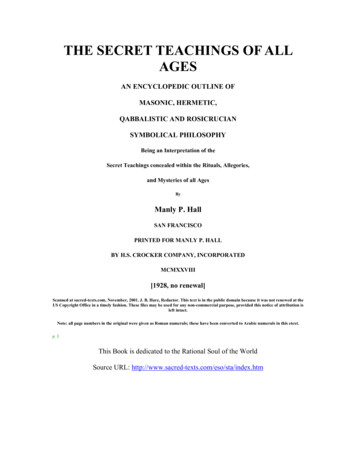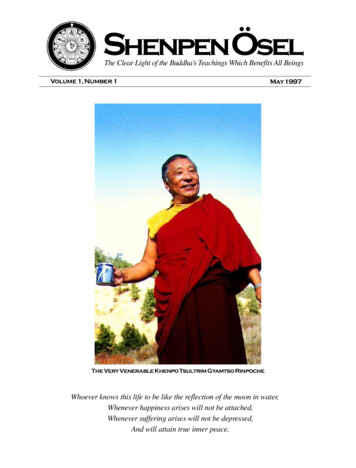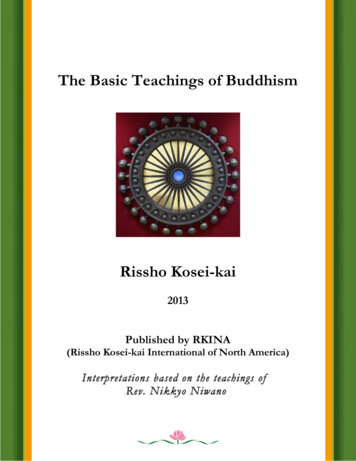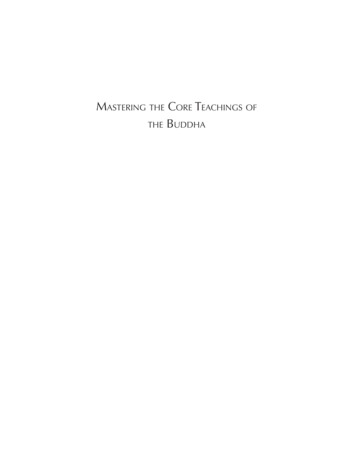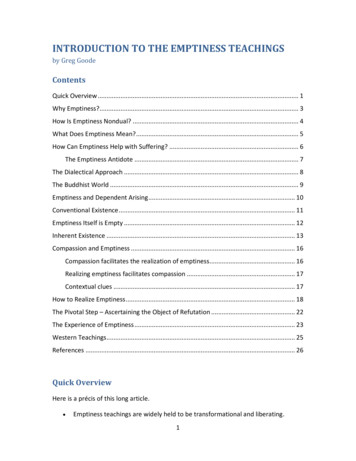
Transcription
INTRODUCTION TO THE EMPTINESS TEACHINGSby Greg GoodeContentsQuick Overview . 1Why Emptiness?. 3How Is Emptiness Nondual? . 4What Does Emptiness Mean? . 5How Can Emptiness Help with Suffering? . 6The Emptiness Antidote . 7The Dialectical Approach . 8The Buddhist World . 9Emptiness and Dependent Arising . 10Conventional Existence . 11Emptiness Itself is Empty . 12Inherent Existence . 13Compassion and Emptiness . 16Compassion facilitates the realization of emptiness. 16Realizing emptiness facilitates compassion . 17Contextual clues . 17How to Realize Emptiness . 18The Pivotal Step – Ascertaining the Object of Refutation . 22The Experience of Emptiness . 23Western Teachings. 25References . 26Quick OverviewHere is a précis of this long article. Emptiness teachings are widely held to be transformational and liberating.1
INTRODUCTION TO THE EMPTINESS TEACHINGS These teachings are found mostly in Buddhism, but analogous teachings exist inthe West as well. Emptiness means interdependence or relationality. In Buddhism, the self and allthings are said to be empty. But empty of what? Empty of inherent, selfsufficient, objective existence. Empty things don't exist inherently or objectively.Instead, they exist by depending on other things, including our means ofinteracting with them. Emptiness is also empty. This is because it too depends on other things. Forexample, the emptiness of the cup depends on the cup and on the conceptualdesignation “emptiness.” Emptiness does not mean non-existence; it means interdependent existence. Emptiness meditations do not refute everyday, conventional existence. Theyrefute inherent, objective existence. The result is that everyday life is clarifiedand freed from the false conceptions of inherent existence. Emptiness and compassion work together. They are interdependent.Compassion promotes the realization of emptiness, and realizing emptinesspromotes compassion. Emptiness meditations usually work like this: You choose something to meditateon, such as the self. You try to get a very clear sense of the inherent existence ofthe self. You use an emptiness meditation to look very deeply for the inherentlyexistent self. You fail to find it; you find its absence instead. Finding the absence of the inherently existent self is realizing the emptiness ofthe self. The experience of emptiness is light, free, open, vibrant and joyful. There is nothing intrinsically superior about emptiness teachings. Many otherteachings also provide a light, free, open, vibrant and joyful way of life.2
INTRODUCTION TO THE EMPTINESS TEACHINGS It doesn't have to be called “emptiness.” Yes, this is a traditional term, but whatit attempts to communicate is a view and a way of life in which the self, others,and phenomena do not have fixed, rigid, independent essences. There are manyother words for this, such as sūnyatā (Sanskrit), anātman (Sanskrit), anatta (Pali),stong-pa nyid (Tibetan), kōng (Chinese), kū (Japanese), gong-seong (Korean),voidness, paticcasamuppāda (Pali), pratītyasamutpāda (Sanskrit), rten cing 'brelbar 'byung ba (Tibetan), and yuánqǐ (Chinese pinyin). English-languageequivalents include dependent arising, interdependence, dependent origination,conditioned genesis, dependent co-arising, interdependent arising, antifoundationalism, anti-essentialism, and freedom without foundations.Why Emptiness?Emptiness is another kind of nondual teaching. Emptiness teachings demonstrate thatthe “I,” as well as everything else, lacks inherent existence. The notion of lackinginherent existence has several senses. In one sense, empty things lack essence, whichmeans that there is no intrinsic quality that makes a thing what it is. In another sense,empty things lack independence, which means that a thing does not exist on its own,apart from conditions, relations or cognition. When you study the emptiness teachings,you start to see how these two senses of “lacking inherent existence” relate to eachother.Emptiness teachings are found mainly in Buddhism, but there are some surprisingparallels in the work of Western thinkers such as Heraclitus of Ephesus (c. 535–475 BCE),Protagoras of Abdera (480–411 BCE), Gorgias of Leontini, Sicily (485–380 BCE), Pyrrho ofElis (c. 360–270 BCE), Sextus Empiricus (c. 160–210 AD), Marcus Tullius Cicero (106–43BCE), Marcus Fabius Quintilianus (c. 35–100 AD), Michel de Montaigne, Thomas Hobbes,David Hume, Martin Heidegger, Ludwig Wittgenstein, Hans-Georg Gadamer, PaulRicoeur, Jacques Derrida, W.V.O. Quine, Wilfrid Sellars, Thomas Kuhn, Paul Feyerabend,Donald Davidson, Richard Rorty, Nelson Goodman, Richard Lanham, John D. Caputo,Richard Bernstein and many others.This Intro will be primarily about Buddhism, because this is a very good place to startone's emptiness study. You get a very clear picture of how realizing emptiness can leadto freedom and peace, and you learn about the importance of compassion. Once theconnection to peace and the importance of compassion are in place to serve as guidesto your study of emptiness (in addition to any teachers you may have), you can combineBuddhist meditations, if you wish, with a huge variety of Western insights.3
INTRODUCTION TO THE EMPTINESS TEACHINGSSome Buddhist sanghas are even beginning to combine Western insights into their ownemptiness teachings. For example (these will open new browserwindows), www.shambhala.org, www.nalandabodhi.org and theidproject.org. This EastWest combination seems quite natural, since no one tradition has a monopoly on peaceof mind. There is more information about Western approaches to emptiness towardsthe end of this article and in many other places on this site.According to Buddhism, when emptiness is realized, peace ensues. One's experience istransformed so that the self, other beings and the world no longer seem like intrinsicallycompartmentalized objects, distinct and separate from each other. The self and allthings are experienced as free.If the selflessness of phenomena is analyzedand if this analysis is cultivated,It causes the effect of attaining nirvana.Through no other cause does one come to peace.—The Samadhiraja SutraHow Is Emptiness Nondual?The most common connotation of “nonduality” is “oneness” or “singularity.” Manyteachings state that everything is actually awareness; those teachings are nondual in the“oneness” sense in which there are no two things.But there is another sense of “nonduality.” Instead of nonduality as “oneness,” it'snonduality as “free from dualistic extremes.” This entails freedom from the pairs ofmetaphysical dualisms such as essentialism/nihilism, existence/non-existence,reification/annihilation, presence/absence, or intrinsicality/voidness, etc. These pairsare dualisms in this sense: if you experience things in the world in terms of one side ofthe pair, you will experience things in the world in terms of the other side as well. Ifsome things seem like they truly exist, then other things will seem like they truly don'texist. You will experience your own self to truly exist, and fear that one day you will trulynot exist. Emptiness teachings show how none of these pairs make sense, and free youfrom experiencing yourself and world in terms of these opposites. Emptiness teachingsare nondual in this sense.Plus, when emptiness is directly realized the way it is explained in some of the Tibetaninfluenced sources (such as Jeffrey Hopkins's Meditation on Emptiness), at thatmoment there is an absence of the sense of a subject/object gap in one's experience.This is a notion of nonduality more similar to that found in awareness-style teachings.4
INTRODUCTION TO THE EMPTINESS TEACHINGSFor those who encounter emptiness teachings after they've become familiar withawareness teachings, it's very tempting to misread the emptiness teachings bysubstituting terms. That is, it's very easy to misread the emptiness teachings by seeing“emptiness” on the page and thinking to yourself, “Awareness, consciousness. I knowwhat they're talking about.”Early in my own study, I began with this substitution in mind. With this misreading, Ifound a lot in the emptiness teachings to be quite INcomprehensible! So I started again,laying aside the notion that “emptiness” and “awareness” were equivalent. I tried to letthe emptiness teachings speak for themselves. I came to find that they have a subtlebeauty and power, a flavor quite different from the awareness teachings. Emptinessteachings do not speak of emptiness as a true nature that underlies or supports things.Rather, it speaks of selves and things as essenceless and free.What Does Emptiness Mean?What are things empty of? According to the Buddhist teachings, things are empty ofinherent existence. Being empty of inherent existence means that there is no essential,fixed or independent way in which things exist. Things have no essential nature. There isno way things truly are, in and of themselves. We will investigate the notion of inherentexistence in more detail below.Different Buddhist schools or tenet systems have different ways of characterizingemptiness; they have different ways of helping students reduce suffering. Mycharacterization of emptiness as taught in Buddhism follows somewhat the TibetanGelug-ba school of Prasangika or “Consequentialist” Madhyamika. This is not the onlytenet system in Buddhism that discusses emptiness. There are other schools withslightly different interpretations of the emptiness teachings. I prefer the TibetanPrasangika interpretation for pragmatic reasons. It has a greater number of publiclyavailable supports for studying and meditating on emptiness than I have seen in otherBuddhist schools. It makes it easier than other varieties of Buddhist teaching toactually use the teachings. The term “Prasangika” is Sanskrit for “consequence.” The“consequence” designation comes from this school's method of debate and refutation,which follows Nagarjuna's style in his Treatise.5
INTRODUCTION TO THE EMPTINESS TEACHINGSHow Can Emptiness Help with Suffering?Buddhism is emphatic about the connection between the emptiness teachings and thealleviation of suffering. But how does this work? To answer this question, I find theBuddhist legend about Gautama leaving home to be quite instructive. The legend helpsus understand what Buddhism means by suffering, and how emptiness teachings canalleviate it.According to the legend, which is a beloved part of the Buddhist teachings, Gautamawas a sheltered prince in India who grew up in a palace where the only people he cameacross were young, healthy and attractive. He grew up, got married and had a son. Oneweek, on four successive days, he went hunting and saw four things he had never seenduring his entire life. An old person. A sick person. A corpse. And a sramana, which is ayogi or renunciant who dedicates his or her life to investigating spiritual questions.Gautama was deeply shaken, and was motivated to become a sramana in order toinvestigate the matters pertaining to life and death. He came to liberation, and out ofcompassion for others, shared his discoveries.Two InsightsThere are two points about this legend that help pinpoint what Buddhism means bysuffering.1. Gautama's life was already going well before he ever began seeking. Accordingto the legend, he was royalty. The legend doesn't mention any sufferings relatedto food, shelter or interpersonal relations.2. The issues that upset Gautama had to do with human impermanence andmortality. Being a member of the royalty was perhaps an easy, pleasant life, butit was not enough to counteract these existential issues.Of course, after a few thousand years, Buddhism has developed activities and practicesfor virtually every facet of life, and like other forms of spirituality, Buddhist activities canmake life beautiful. But these two points about Gautama help us understand the pointof his own search. It was about the big stuff, the existential issues surrounding life,impermanence and death. Gautama's search was about how upsetting and shocking itcan be to regard one's life as fixed in some way and then see it start to come to an end.If we regard events to have an objective meaning for our life (and vice-versa), and if weregard our life to be metaphysically independent and governed by the self-same identitythrough time, we'll cling to life and protest as we notice changes we don't like. We'll6
INTRODUCTION TO THE EMPTINESS TEACHINGSregard life as something that we think ought to really and truly be there, and maybeforever. In the midst of this clinging, we will be painfully shaken when we confrontevidence of life fading away and ending. And through time, the evidence gets strongerand stronger.Suffering is said to come from conceiving that we and the world have fixed, independentand unchangeable natures that exist on their own without help from anything else. Weexpect that there is a true way that self and world truly are and ought to be. Theseexpectations are unrealistic and prevent us from granting things the freedom to comeand go and change. We like pleasant things to abide permanently, and unpleasantthings to never occur. We experience suffering when we actually encounter comings,goings and change. Suffering often takes the form of anger, indignation, existentialanxiety, and even a sense that, as they say in TV sitcoms, “something is wrong with thispicture.”One of Gautama's liberating discoveries was that one's life (and indeed all other things)are pervaded by impermanence, unsatisfactoriness and no-self. Things are pervadedby impermanence because they don't last forever. Things are pervadedby unsatisfactoriness, not only because pleasant things come to an end and unpleasantthings begin, but more profoundly because if our happiness depends on objects orstates that come and go, we will not be able to find deep satisfaction. And things arepervaded by no-self because under even extremely close examination, there's noevidence that anything has an inherent nature or an objective existence.The Emptiness AntidoteThe emptiness teachings serve as an antidote to this existential suffering by inspiringpeace, and freedom from clinging to changing objects. Peace can be experienced in themidst of flux. Sometimes this may sound like bad news. One may think, “So, emptinessteachings are gonna make it easier to die? How depressing!” But the emptinessteachings make it easier to live. They remove suffering by removing existential clinging,which is caused by the deep-seated but false demands for permanence, pleasantnessand self-identity. If we're OK about the big stuff, we'll have ways of transforming thesmall stuff as well. Emptiness teachings do not deny life; they transform life in a waythat makes it light-hearted, joyful and vibrantly alive.The emptiness teachings examine the supposed inherent self; they allow you to realizethat there isn't one. But the teachings are not limited to examining one's self. They alsoexamine the entire range of other beings and objects. The reason for such a broadspectrum is this. We may have realized that our self is empty. But if there is anything we7
INTRODUCTION TO THE EMPTINESS TEACHINGSstill regard as inherent, self-natured or objectively existent, our sense of inherency is notgone. We can always use those other things that we still regard as inherent as a pretextto return to thinking that we ourselves are also inherent. And suffering can return. Sothere is nothing that the emptiness teachings say not to investigate.Even emptiness must be investigated sooner or later, because not even emptiness isinherent, self-natured or objectively existent.The Dialectical ApproachThe Consequentialists do not argue for substantive positions, but proceed dialectically.They argue by drawing out the unwanted and unexpected logical consequences entailedby their interlocutors' positions. The Consequentialist style of refutation is as follows:while in debate over metaphysical issues with an interlocutor, the Consequentialistrefutes the interlocutor not by negating the interlocutor's statement with a counterstatement (e.g., that matter exists, not Mind), but by finding an inconsistency orincoherent assumption buried amidst the interlocutor's statements. This allowsConsequentialism to be positionless with respect to issues, most notably on questions ofexistence and non-existence.Imagine a philosopher coming up to a man who is sitting quietly against a tree, andtelling the man that the tree truly exists because it is truly independent of the mind thatcognizes it. Our sitting man is a consequentialist. He doesn't have an opinion on theexistence or non-existence of the tree, and doesn't wish to convince the philosopher ofa contrary position; he's just sitting there. So he won't offer a counter-claim or arguethat the tree really doesn't exist independently of cognition. Instead, he will draw outmore statements from the philosopher until the philosopher is obviously involved in acontradiction or other difficulty. Or he might show that the philosopher's assumptionsentail an absurd, unwanted conclusion. Then he'll go back to sitting against the tree.The Consequentialist school is the most thoroughgoing of the Mahayana schools in itsrejection of any kind of intrinsic nature. Even though it is the school of His Holiness thecurrent Dalai Lama, most of the Dalai Lama's public teachings are about other topics ofwider interest. Emptiness teachings can get abstract and subtle, and not everyone isinterested in them. But if you do find books in English on emptiness, most of them arelikely to be written from the Consequentialist standpoint. You will find a list of thesebooks in the References section below.8
INTRODUCTION TO THE EMPTINESS TEACHINGSThe Buddhist WorldAccording to the Buddhist emptiness teachings, the world is made up only of things thatare “selfless” or empty. Even non-existents are empty. Non-existents would includeround squares, the hairs of a turtle, etc., as well as inherent existence. Existents aredivided into two classes, compounded things and non-compunded things.Compounded things are said to disintegrate moment-to-moment, in a way analogous toaging. They are impermanent in this sense. Compounded things have pieces or parts andare produced from combinations of other factors. Compounded things include physicalobjects, colors, shapes, powers, sensations, thoughts, intentions, feelings, persons,collections and states of being. These various things fall under the categories of Form,Consciousness and Compositional Factors. Form includes components of the physicalworld, the body, the physical sense organs, and colors and shapes. Consciousnessincludes mental phenomena, sensory functions and thinking processes. Compositionalfactors include volition, decision, intention, thoughts, ideas and opinions. It alsofunctions as a catch-all category that includes “everything else that exists but is notpermanent” (see Translating Buddhism from Tibetan, Joe B. Wilson, p. 147).Non-compounded things do not disintegrate moment-to-moment. In this sense, theyare said to be “permanent.” There are two kinds of “permanent” existent. There are“occasional permanents,” which come into existence and go out of existence. Theseinclude, for example, the space inside the cup and the emptiness of the cup. Eventhough the cup is compounded and consists of parts (such as the rim, the handle, thewalls, etc.), the space inside the cup and the emptiness of the cup are not compoundedand do not consist of parts. Also, the emptiness of the cup and the space inside the cupstop existing when the cup stops existing. There are also “non-occasional permanents,”such as emptiness in general and space in general. These are the referents of generalconcepts, and exist as long as any objects or relations exist.For the student of emptiness, it is not important to remember or utilize this scheme oremploy these categories in one's day-to-day use. What is important is to learn thelessons taught by this scheme: Everything is said to be empty, even emptiness For each thing, there is also the corresponding emptiness of that thing, becauseto exist is to be empty Inherent existence falls under the category of non-existent things9
INTRODUCTION TO THE EMPTINESS TEACHINGSThis last point is especially important when it comes to meditating on emptiness. Whenyou meditate on emptiness, what you actually look for is inherent existence. Instead offinding inherent existence, you will find the lack of inherent existence. This lack itself isemptiness.Emptiness and Dependent ArisingAccording to the Mahayana paths of Buddhism that emphasize the notion, emptiness iswhat the early Buddhist sutras were pointing to when they presented the notionof pratītyasamutpāda (Sanskrit) or paticcasamuppāda (Pali), namely “dependentarising”:There is the case where a disciple of the noble ones notices:When this is, that is.From the arising of this comes the arising of that.When this isn't, that isn't.From the cessation of this comes the cessation of that.— Anguttara Nikaya X.92; Vera Sutta)Centuries later, Nagarjuna (2nd century C. E.) became the preeminent expositor ofemptiness teachings. His Mūlamadhyamakakārikā (Treatise on the Middle Way) is todayconsidered the most profound and sophisticated exposition of emptiness in Buddhism.The text provides scores of arguments for the conclusion that to propose any kind ofinherent existence or metaphysical essence involves the proponent in logicalcontradictions and incoherence. Chapter 24 actually contains two specific verses thatcharacterize the notion of emptiness itself:Whatever is dependently co-arisen,That is explained to be emptiness.That, being a dependent designation,Is itself the middle way. — (Treatise, 24.18)Something that is not dependently arisen,Such a thing does not exist.Therefore a nonempty thingDoes not exist. — (Treatise, 24.19)In verse 18, Nagarjuna sets up a three-way equivalence:10
INTRODUCTION TO THE EMPTINESS TEACHINGSemptiness dependent arising verbal convention 1and identifies this equivalence with the Middle Way. The Middle Way is a form ofnonduality that is free from the dualistic opposites of essentialism and nihilism. Evenemptiness itself is characterized as being empty. It is empty because, instead of havingthe inherent nature of being dependent arising, it is merely “explained to be”dependent arising.In verse 19, Nagarjuna states that whatever exists, is in some sense dependently arisen,that is, empty. If something is not dependently arisen, then it is not empty. If it is notempty, then it does not exist. And of course, even things we would normally consider asnon-existent, such as unicorns and round squares, are also empty.Conventional ExistenceSo how do things exist if they don't exist inherently? According to the Buddhistteachings, things exist in an everyday, non-inherent, dependent way. Our mode ofexistence is dependent on many things, such as the causes and conditions that give riseto us, the components that make us up, and the ways we are cognized and categorized.According to the teachings, we are not separate and independent entities, but rather weexist in dependence on webworks of relations and transactions.For example, we can say that a bottle of milk exists in a dependent, conventional waybecause you can go to the store, lift the bottle of milk off the shelf, pay for it and bring ithome. It exists in dependence on its surroundings, its having been manufactured, and inrelation to the actions of the store employees and yourself. The bottle of milk is notfound to exist independently of these things.It is taught that all things are empty and dependent like this. That includes people andall other living beings, as well as consciousness and unconsciousness; pleasure and pain;time and space; cause and effect; good and bad; logic and math; language, meaning andreference; art, commerce and science; planets, boulders and bridges; unicorns andSherlock Holmes; energy, thoughts, feelings and bodily sensations. Whatever exists issaid to exist conventionally, but not inherently.This insight is very clearly set forth by Jay Garfield in his Fundamental Wisdom of the Middle Way, pp.303-321.111
INTRODUCTION TO THE EMPTINESS TEACHINGSEmptiness Itself is EmptyEven emptiness is empty. For example, the emptiness of the bottle of milk does notexist inherently. Rather, it exists in a dependent way. The emptiness of the bottle of milkis dependent upon its basis (the bottle of milk). It is also dependent upon having beendesignated as emptiness. As we saw above, this is alluded to in Nagarjuna's Treatise,verse 24.18.Understood this way, emptiness is not a substitute term for awareness. Emptiness is notan essence. It is not a substratum or background condition. Things do not arise out ofemptiness and subside back into emptiness. Emptiness is not a quality that things have,which makes them empty. Rather, to be a thing in the first place, is to be empty.It is easy to misunderstand emptiness by idealizing or reifying it by thinking that it is anabsolute, an essence, or a special realm of being or experience. It is not any of thosethings. It is actually the opposite. It is merely the way things exist, which is withoutessence or self-standing nature or a substratum of any kind. Here is a list characteristicsof emptiness, to help avoid some of the frequent misunderstandings about emptiness,according to the Buddhist Consequentialists: Emptiness is not a substance Emptiness is not a substratum or background Emptiness is not light Emptiness is not consciousness or awareness Emptiness is not the Absolute Emptiness does not exist on its own Objects do not consist of emptiness Objects do not arise from emptiness Emptiness of the “I” does not negate the “I” Emptiness is not the feeling that results when no objects are appearing to themind Meditating on emptiness does not consist of quieting the mind12
INTRODUCTION TO THE EMPTINESS TEACHINGSInherent ExistenceInherent existence is the kind of existence we uncritically think things have, existingunder their own power, without help from anything else. Our sense that things exist inthis way is the root of our suffering, according to the Buddhist teachings. We have asense of this inherence partly due to how we think of language. We think that words arelabels pointing straight to pre-formatted, already-individuated things in the worldoutside of language or cognition. This tendency to feel inherence can even be intensifiedif we follow essentialist philosophies such as Platonism or materialist realism, whichhold that things exist according to their own essential nature, independent of anythingelse. Our natural tendency to feel this inherence is the root of suffering, according tothe emptiness teachings. Actually, being able to locate and isolate this sense of inherentexistence in yourself is good news. The more clearly you can grasp the sense of inherentexistence, the more powerfully you will be able to realize emptiness when you do yourmeditations.What does the sense of inherent existence feel like? We will say much more about thislater, but briefly, it feels like something is really there, just like that, being what it reallyis. You've had a very definite sense of inherent existence if you've ever wonderedwhether something or someone has been given the “correct” name! Or could it perhapshave been given the wrong name?According to the emptiness teachings, inherent existence is the kind of existence thatthings do not have. Things actually lack inherent existence, because they exist asdependent arisings. This dependency is the lack of inherent existence which, in turn, istheir emptiness.The relation between inherent existence, emptiness and dependent arising can be seenthrough the translation of the Sanskrit or Pali terms for dependingarising: pratītyasamutpāda (Sanskrit) or paticcasamuppāda (Pali). The Sanskritcomponents are individually translated as follows:Pratītya Meeting, Relying or Depending Samut Out of Pad To go, to f
on, such as the self. You try to get a very clear sense of the inherent existence of the self. You use an emptiness meditation to look very deeply for the inherently . teachings also provide a light, free, open, vibrant and joyful way of life. . characterization of emptiness as taught in Buddhism follows
